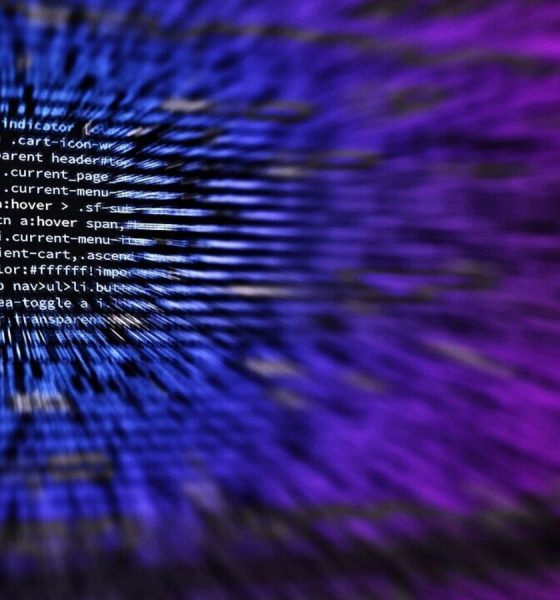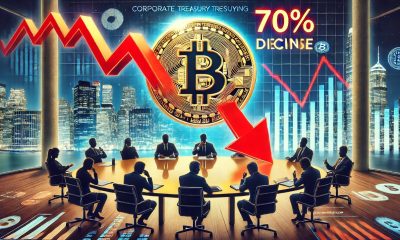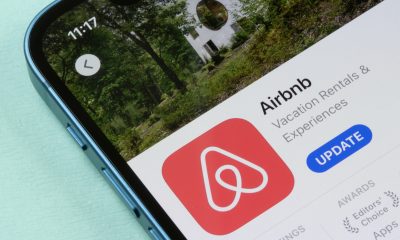

Metaverse
At least 10% of research may already be co-authored by AI – Crypto News
It is a question ever more readers of scientific papers are asking. Large language models (LLMs) are now more than good enough to help write a scientific paper. They can breathe life into dense scientific prose and speed up the drafting process, especially for non-native English speakers. Such use also comes with risks: LLMs are particularly susceptible to reproducing biases, for example, and can churn out vast amounts of plausible nonsense. Just how widespread an issue this was, though, has been unclear.
In a preprint posted recently on arXiv, researchers based at the University of Tübingen in Germany and Northwestern University in America provide some clarity. Their research, which has not yet been peer-reviewed, suggests that at least one in ten new scientific papers contains material produced by an LLM. That means over 100,000 such papers will be published this year alone. And that is a lower bound. In some fields, such as computer science, over 20% of research abstracts are estimated to contain LLM-generated text. Among papers from Chinese computer scientists, the figure is one in three.
Spotting LLM-generated text is not easy. Researchers have typically relied on one of two methods: detection algorithms trained to identify the tell-tale rhythms of human prose, and a more straightforward hunt for suspicious words disproportionately favoured by LLMs, such as “pivotal” or “realm”. Both approaches rely on “ground truth” data: one pile of texts written by humans and one written by machines. These are surprisingly hard to collect: both human- and machine-generated text change over time, as languages evolve and models update. Moreover, researchers typically collect LLM text by prompting these models themselves, and the way they do so may be different from how scientists behave.
View Full Image
The latest research by Dmitry Kobak, at the University of Tübingen, and his colleagues, shows a third way, bypassing the need for ground-truth data altogether. The team’s method is inspired by demographic work on excess deaths, which allows mortality associated with an event to be ascertained by looking at differences between expected and observed death counts. Just as the excess-deaths method looks for abnormal death rates, their excess-vocabulary method looks for abnormal word use. Specifically, the researchers were looking for words that appeared in scientific abstracts with a significantly greater frequency than predicted by that in the existing literature (see chart 1). The corpus which they chose to analyse consisted of the abstracts of virtually all English-language papers available on PubMed, a search engine for biomedical research, published between January 2010 and March 2024, some 14.2m in all.
The researchers found that in most years, word usage was relatively stable: in no year from 2013-19 did a word increase in frequency beyond expectation by more than 1%. That changed in 2020, when “SARS”, “coronavirus”, “pandemic”, “disease”, “patients” and “severe” all exploded. (Covid-related words continued to merit abnormally high usage until 2022.)

View Full Image
By early 2024, about a year after LLMs like ChatGPT had become widely available, a different set of words took off. Of the 774 words whose use increased significantly between 2013 and 2024, 329 took off in the first three months of 2024. Fully 280 of these were related to style, rather than subject matter. Notable examples include: “delves”, “potential”, “intricate”, “meticulously”, “crucial”, “significant”, and “insights” (see chart 2).
The most likely reason for such increases, say the researchers, is help from LLMs. When they estimated the share of abstracts which used at least one of the excess words (omitting words which are widely used anyway), they found that at least 10% probably had LLM input. As PubMed indexes about 1.5m papers annually, that would mean that more than 150,000 papers per year are currently written with LLM assistance.

View Full Image
This seems to be more widespread in some fields than others. The researchers’ found that computer science had the most use, at over 20%, whereas ecology had the least, with a lower bound below 5%. There was also variation by geography: scientists from Taiwan, South Korea, Indonesia and China were the most frequent users, and those from Britain and New Zealand used them least (see chart 3). (Researchers from other English-speaking countries also deployed LLMs infrequently.) Different journals also yielded different results. Those in the Nature family, as well as other prestigious publications like Science and Cell, appear to have a low LLM-assistance rate (below 10%), while Sensors (a journal about, unimaginatively, sensors), exceeded 24%.
The excess-vocabulary method’s results are roughly consistent with those from older detection algorithms, which looked at smaller samples from more limited sources. For instance, in a preprint released in April 2024, a team at Stanford found that 17.5% of sentences in computer-science abstracts were likely to be LLM-generated. They also found a lower prevalence in Nature publications and mathematics papers (LLMs are terrible at maths). The excess vocabulary identified also fits with existing lists of suspicious words.
Such results should not be overly surprising. Researchers routinely acknowledge the use of LLMs to write papers. In one survey of 1,600 researchers conducted in September 2023, over 25% told Nature they used LLMs to write manuscripts. The largest benefit identified by the interviewees, many of whom studied or used AI in their own work, was to help with editing and translation for those who did not have English as their first language. Faster and easier coding came joint second, together with the simplification of administrative tasks; summarising or trawling the scientific literature; and, tellingly, speeding up the writing of research manuscripts.
For all these benefits, using LLMs to write manuscripts is not without risks. Scientific papers rely on the precise communication of uncertainty, for example, which is an area where the capabilities of LLMs remain murky. Hallucination—whereby LLMs confidently assert fantasies—remains common, as does a tendency to regurgitate other people’s words, verbatim and without attribution.
Studies also indicate that LLMs preferentially cite other papers that are highly cited in a field, potentially reinforcing existing biases and limiting creativity. As algorithms, they can also not be listed as authors on a paper or held accountable for the errors they introduce. Perhaps most worrying, the speed at which LLMs can churn out prose risks flooding the scientific world with low-quality publications.
Academic policies on LLM use are in flux. Some journals ban it outright. Others have changed their minds. Up until November 2023, Science labelled all LLM text as plagiarism, saying: “Ultimately the product must come from—and be expressed by—the wonderful computers in our heads.” They have since amended their policy: LLM text is now permitted if detailed notes on how they were used are provided in the method section of papers, as well as in accompanying cover letters. Nature and Cell also allow its use, as long as it is acknowledged clearly.
How enforceable such policies will be is not clear. For now, no reliable method exists to flush out LLM prose. Even the excess-vocabulary method, though useful at spotting large-scale trends, cannot tell if a specific abstract had LLM input. And researchers need only avoid certain words to evade detection altogether. As the new preprint puts it, these are challenges that must be meticulously delved into.
© 2024, The Economist Newspaper Limited. All rights reserved. From The Economist, published under licence. The original content can be found on www.economist.com
-

 Cryptocurrency6 days ago
Cryptocurrency6 days agoIlluminating progress: Is a $140K income ‘poor’? – Crypto News
-
Technology5 days ago
Crypto Lawyer Bill Morgan Praises Ripple’s Multi-Chain Strategy as RLUSD Hits $1.1B – Crypto News
-

 others6 days ago
others6 days agoGold holds strong at $4,200 as Fed-cut anticipation builds – Crypto News
-

 Blockchain4 days ago
Blockchain4 days agoAnalyst Reveals What You Should Look Out For – Crypto News
-
Cryptocurrency1 week ago
Crypto Platform Polymarket Relaunches in U.S. Following CFTC Approval – Crypto News
-

 Cryptocurrency1 week ago
Cryptocurrency1 week agoUK recognises crypto as property in major digital asset shift – Crypto News
-
others7 days ago
Bitcoin Price Forecast as BlackRock Sends $125M in BTC to Coinbase — Is a Crash Inevitable? – Crypto News
-

 Technology6 days ago
Technology6 days agoSamsung Galaxy S25 Ultra 5G for under ₹80,000 on Flipkart? Here’s how the deal works – Crypto News
-

 Blockchain3 days ago
Blockchain3 days agoStripe and Paradigm Open Tempo Blockchain Project to Public – Crypto News
-
others1 week ago
$12T Charles Schwab to Launch Bitcoin and Ethereum Trading in Early 2026, CEO Confirms – Crypto News
-

 Cryptocurrency1 week ago
Cryptocurrency1 week ago‘Get it done on time’ – Lawmakers push regulators on GENIUS Act rollout – Crypto News
-
Business1 week ago
Crypto Platform Polymarket Relaunches in U.S. Following CFTC Approval – Crypto News
-

 Technology7 days ago
Technology7 days agoWorking on a screen all day? These 8 LED monitors in Dec 2025 are kinder on your eyes – Crypto News
-
others6 days ago
Morgan Stanley Turns Bullish, Says Fed Will Cut Rates by 25bps This Month – Crypto News
-

 Cryptocurrency6 days ago
Cryptocurrency6 days agoFlorida Appeals Court Revives $80M Bitcoin Theft – Crypto News
-

 Cryptocurrency6 days ago
Cryptocurrency6 days agoCrypto Holiday Gift Guide 2025 – Crypto News
-
others4 days ago
Breaking: Labor Department Cancels October PPI Inflation Report Ahead of FOMC Meeting – Crypto News
-

 Cryptocurrency4 days ago
Cryptocurrency4 days agoArgentina moves to reshape crypto rules as banks prepare for Bitcoin services – Crypto News
-
others1 week ago
XRP News: Ripple Expands Payments Service With RedotPay Integration – Crypto News
-
Business1 week ago
Sui Price Surges 10% As Vanguard Group Adds SUI to Bitwise 10 Crypto Index – Crypto News
-

 Cryptocurrency1 week ago
Cryptocurrency1 week agoRipple CTO Shares Hilarious Email from Jed McCaleb Impersonator – Crypto News
-
Business1 week ago
Senator Tim Scott Floats December 17 and 18 For Crypto Market Bill Markup – Crypto News
-

 Cryptocurrency1 week ago
Cryptocurrency1 week agoBTC staking platform Babylon teams up with Aave for Bitcoin-backed DeFi insurance – Crypto News
-

 Blockchain1 week ago
Blockchain1 week agoSolana (SOL) Cools Off After Rally While Market Eyes a Resistance Break – Crypto News
-

 others6 days ago
others6 days agoThe rally to 7120 continues – Crypto News
-

 Blockchain6 days ago
Blockchain6 days agoBitcoin Buries The Tulip Myth After 17 Years: Balchunas – Crypto News
-

 others5 days ago
others5 days agoNasdaq futures hold key structure as price compresses toward major resistance zones – Crypto News
-

 others5 days ago
others5 days agoNasdaq futures hold key structure as price compresses toward major resistance zones – Crypto News
-
Business1 week ago
Trump Sets Early 2026 Timeline for New Fed Chair Pick – Crypto News
-

 Cryptocurrency1 week ago
Cryptocurrency1 week agoVanguard reverses course, opens door to Bitcoin, Ethereum, XRP, and Solana ETFs – Crypto News
-

 Technology1 week ago
Technology1 week agoTinder says 2026 will be the year of ‘no mixed signals’ as daters embrace clarity – Crypto News
-

 Blockchain1 week ago
Blockchain1 week agoLedger Finds Chip Flaw Allowing Complete Phone Takeover – Crypto News
-
Business1 week ago
Kalshi, Robinhood and Crypto com Face Cease & Desist Order in Connecticut – Crypto News
-
Business1 week ago
What’s Next for Dogecoin Price After Whales Scoop 480M DOGE? – Crypto News
-

 Technology1 week ago
Technology1 week agoCloudflare Resolved Services Issues Caused by Software Update – Crypto News
-
others1 week ago
XRP Price Prediction As Spot ETF Inflows Near $1 Billion: What’s Next? – Crypto News
-
others7 days ago
Colombia Consumer Price Index (YoY) below forecasts (5.45%) in November: Actual (5.3%) – Crypto News
-
Technology7 days ago
Solana Price Outlook: Reversal at Key Support Could Lead to $150 Target – Crypto News
-

 Technology6 days ago
Technology6 days agoFrom security camera to gaming hub: 6 Easy tricks to make your old smartphone genuinely useful again – Crypto News
-

 Cryptocurrency5 days ago
Cryptocurrency5 days agoWhy Ethereum strengthens despite whale selling – Inside Asia premium twist – Crypto News
-

 Technology5 days ago
Technology5 days agoStarlink India pricing revealed: How much does monthly plan cost and what are its benefits? – Crypto News
-
Cryptocurrency1 week ago
Hedera Price Surges 10% After Canary Capital HBAR ETF Goes Live on Vanguard – Crypto News
-

 Blockchain1 week ago
Blockchain1 week agoLeveraged ETFs Tied To Strategy Suffer Major Losses – Crypto News
-

 Metaverse1 week ago
Metaverse1 week agoIndian enterprises all-set to take an AI leap as partners guide adoption – Crypto News
-
Business1 week ago
December Fed Rate Cut Prospects Strengthen After ADP Shows Deepening Labor Market Weakness – Crypto News
-

 Blockchain1 week ago
Blockchain1 week agoTaiwan to Pass Stablecoin Regulations in Late 2026: Report – Crypto News
-

 Cryptocurrency1 week ago
Cryptocurrency1 week agoEric Trump’s American Bitcoin Steadies After ‘First Major Unlock’ of Shares – Crypto News
-

 Blockchain1 week ago
Blockchain1 week agoAnalysts Turn Bullish on SUI as Token Extends Gains Amid Renewed Institutional Interest – Crypto News
-

 Cryptocurrency1 week ago
Cryptocurrency1 week agoCayman Islands sees rising Web3 foundation activity – Crypto News
-

 Technology1 week ago
Technology1 week agoApple Watch’s latest update drops a lifesaving feature for Indian users: here’s how it works – Crypto News










